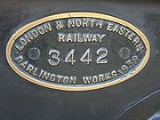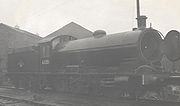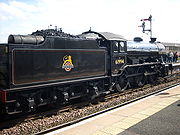
Darlington Works
Encyclopedia
Darlington railway works, known in the town as North Road Shops, was built in 1863 by the Stockton and Darlington Railway
in the town of Darlington
in the north east of England.

 The first new locomotive was built at the works in 1864. Though the railway had amalgamated with the North Eastern Railway
The first new locomotive was built at the works in 1864. Though the railway had amalgamated with the North Eastern Railway
(NER) in 1863, it continued to build its own designs for a number of years. In 1877 the first North Eastern designs appeared.
In 1914 a class of NER Bo+Bo electric locomotives were built at the works to run between Shildon and Newport. Ten of these 1500 volt direct current locomotives were completed.
Sir Vincent Raven designed the NER Class T2
0-8-0 freight locomotive in 1913, and by 1921 the works had built 120 of the engines, which were later designated Q6 by the LNER. The heavier and more powerful Raven NER Class T3
0-8-0 (LNER Q7) followed in 1919, 15 engines being completed by 1924.
 Under the LNER
Under the LNER
it continued to play a major role, producing a new engine each week, with Gresley
's K3
class 2-6-0
appearing in 1924. Both the class V2 and A1 express locomotives were also built. By 1927 the works was the town's largest employer.
Darlington works built six LNER Class K4
2-6-0 locomotives in 1937/38 for operation on the West Highland Line. No. 3442 (later 61994) The Great Marquess has been preserved in full working order and in 2009 was still hauling special steam trains on the UK main line network.
. The equivalent of the LNER Class E1 0-6-0
tank locomotive
had been built, virtually unchanged since 1898. In 1954 during the modernisation of British Rail
ways the works was enlarged, but in 1962 the BR Workshops Division was formed and, with the rationalisation the works was run down and closed in 1966.
Stockton and Darlington Railway
The Stockton and Darlington Railway , which opened in 1825, was the world's first publicly subscribed passenger railway. It was 26 miles long, and was built in north-eastern England between Witton Park and Stockton-on-Tees via Darlington, and connected to several collieries near Shildon...
in the town of Darlington
Darlington
Darlington is a market town in the Borough of Darlington, part of the ceremonial county of County Durham, England. It lies on the small River Skerne, a tributary of the River Tees, not far from the main river. It is the main population centre in the borough, with a population of 97,838 as of 2001...
in the north east of England.

NER History

North Eastern Railway (UK)
The North Eastern Railway , was an English railway company. It was incorporated in 1854, when four existing companies were combined, and was absorbed into the London and North Eastern Railway at the Grouping in 1923...
(NER) in 1863, it continued to build its own designs for a number of years. In 1877 the first North Eastern designs appeared.
In 1914 a class of NER Bo+Bo electric locomotives were built at the works to run between Shildon and Newport. Ten of these 1500 volt direct current locomotives were completed.
Sir Vincent Raven designed the NER Class T2
NER Class T2
The North Eastern Railway Class T2, classified as Class Q6 by the LNER, is a class of 0-8-0 steam locomotive designed for heavy freight. 120 were built at Darlington Works between 1913 and 1921 to the design of Vincent Raven, based on the NER Class T and T1 .All passed into British Railways...
0-8-0 freight locomotive in 1913, and by 1921 the works had built 120 of the engines, which were later designated Q6 by the LNER. The heavier and more powerful Raven NER Class T3
NER Class T3
North Eastern Railway Class T3, classified Q7 by the LNER is a class of 0-8-0 steam locomotive designed for heavy freight. Five were built by the NER in 1919 and a further 10 by the London and North Eastern Railway in 1924.-Performance:...
0-8-0 (LNER Q7) followed in 1919, 15 engines being completed by 1924.
LNER history

London and North Eastern Railway
The London and North Eastern Railway was the second-largest of the "Big Four" railway companies created by the Railways Act 1921 in Britain...
it continued to play a major role, producing a new engine each week, with Gresley
Nigel Gresley
Sir Herbert Nigel Gresley was one of Britain's most famous steam locomotive engineers, who rose to become Chief Mechanical Engineer of the London and North Eastern Railway . He was the designer of some of the most famous steam locomotives in Britain, including the LNER Class A1 and LNER Class A4...
's K3
K3
-Transportation:* K-3 , a state highway in Kansas* London Buses route K3* Taquan Air, IATA airline designator for the Alaskan commuter airline-Vehicles:* LNER Class K3, a steam locomotive...
class 2-6-0
2-6-0
Under the Whyte notation for the classification of steam locomotives, 2-6-0 represents the wheel arrangement of two leading wheels on one axle, usually in a leading truck, six powered and coupled driving wheels on three axles, and no trailing wheels. This arrangement is commonly called a Mogul...
appearing in 1924. Both the class V2 and A1 express locomotives were also built. By 1927 the works was the town's largest employer.
Darlington works built six LNER Class K4
LNER Class K4
The London and North Eastern Railway Class K4 is a class of 2-6-0 steam locomotives designed by Nigel Gresley for the steep grades of the West Highland Line.- West Highland Line challenge :...
2-6-0 locomotives in 1937/38 for operation on the West Highland Line. No. 3442 (later 61994) The Great Marquess has been preserved in full working order and in 2009 was still hauling special steam trains on the UK main line network.
Nationalisation
After nationalisation, Darlington built both steam and diesel locomotives, including BR standard class 2BR standard class 2 2-6-0
The BR Standard Class 2 2-6-0 is a class of steam locomotive, one of the British Railways Standard classes of the 1950s. They were physically the smallest of the Standard classes; 65 were built....
. The equivalent of the LNER Class E1 0-6-0
0-6-0
Under the Whyte notation for the classification of steam locomotives, 0-6-0 represents the wheel arrangement of no leading wheels, six powered and coupled driving wheels on three axles, and no trailing wheels...
tank locomotive
Tank locomotive
A tank locomotive or tank engine is a steam locomotive that carries its water in one or more on-board water tanks, instead of pulling it behind it in a tender. It will most likely also have some kind of bunker to hold the fuel. There are several different types of tank locomotive dependent upon...
had been built, virtually unchanged since 1898. In 1954 during the modernisation of British Rail
British Rail
British Railways , which from 1965 traded as British Rail, was the operator of most of the rail transport in Great Britain between 1948 and 1997. It was formed from the nationalisation of the "Big Four" British railway companies and lasted until the gradual privatisation of British Rail, in stages...
ways the works was enlarged, but in 1962 the BR Workshops Division was formed and, with the rationalisation the works was run down and closed in 1966.

